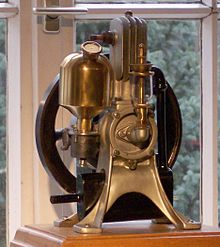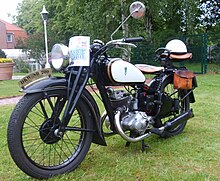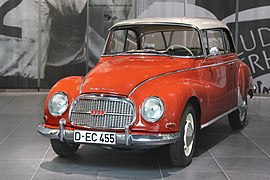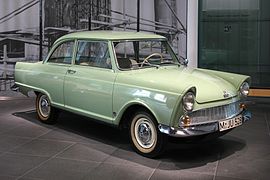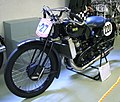DKW
DKW ( Dampf-Kraft-Wagen ) is a former German automobile and motorcycle brand .
history
The early years
In 1904 the Dane Jørgen Skafte Rasmussen, together with his partner Carl Ernst, registered the company Rasmussen & Ernst in the commercial register of the city of Chemnitz , responsible for the sale of machines and devices of all kinds. In 1906, Rasmussen bought a former cloth factory in Zschopau in the valley of the brook Tischau and relocated his company there. In the Zschopau commercial register entry of April 13, 1907, only he was entered as the owner, although Ernst was also mentioned in the company name (company) until 1912. The sales office remained in Chemnitz. The company was placed on a wide range of products from accessories for steam engines to household appliances and devices for electrotherapy and was called Rasmussen & Ernst, Zschopau-Chemnitz, Maschinen- und Armaturenfabrik, Apparatebau Anstalt from 1909 . In 1913, a legal separation was carried out between Rasmussen and Ernst and the manufacturing company that has since 1912 been called Zschopauer Maschinenfabrik J. S. Rasmussen .
At the beginning of the First World War , operations came to an almost complete standstill, and Rasmussen tried to get military contracts. With the manufacture of fuses, the company was even able to expand during this time, so that Rasmussen employed around 480 people at the end of 1915.
1916-17 began Rasmussen together with his former classmates Mathiesen the development of a D ampf k raft w agen, funded by the German military authorities. After the First World War, however, interest in this technology decreased significantly and the project was discontinued in 1921. A total of ten to twelve steam cars were built as passenger and truck. All that was left of it were the three letters DKW, which Rasmussen had registered as a trademark.
About the same time as the start of the steam car development the company acquired the rights to a two-stroke -Kleinmotor of Hugo Ruppe from Apolda who first cc at 18 and 0.25 horsepower than D is K hub W unsightly and modern alternative to toy steam engine was quite successfully marketed.
Was best seller of 1921 the further developed from the toy motor, and production-ready bike enlarged auxiliary motor D as K leash W under , for with the saying "... drives uphill like others down!" Was advertised and sold by the alone 1921 over 10,000 pieces. The engine with a cubic capacity of 118 cm³ and an output of 1 HP was mounted on the luggage rack and was therefore popularly known as Arschwärmer . The engine was presented as early as 1919 and was first delivered to a customer in 1920. On the basis of this engine and using a Slaby-Beringer electric car, Rasmussen built the first DKW automobile in 1920, but it did not go beyond prototype status. However, there were advertisements in which the little cart, which weighs 250 kg, should be available at 60 km / h at short notice when Der kleine Bergsteiger was announced. The engine of this first DKW (written with dots in the ad) was mounted on the running board; Driver and passenger sat one behind the other. This engine was also offered by DKW as the first stationary engine.
In 1921, the Zschopauer Maschinenfabrik added the Golem from the Berlin motorcycle manufacturer Ernst Eichler to its production and sales program, a two-wheeler with small wheels and the 1-hp DKW engine that was installed horizontally in the frame. The driving characteristics were unsatisfactory, however, so that just one year later Eichler brought out the so-called Lomos armchair motorcycle , a forerunner of the scooter. In contrast to most motorcycles of its time, this two-wheeler already had rear suspension ( swing arm with shock absorber ).
Zschopauer Motorenwerke JS Rasmussen AG , founded in 1923, continued to use the DKW brand with the plant operation.
From 1927/28 onwards, it also manufactured refrigerators of this brand ( Das Kühl Wunder ) in Scharfenstein . The brand and the introduced term of DKW cooling continued to be used after its subsidiary Deutsche Kühl- und Kraftmaschinen GmbH (DKK) was created for this division in 1931 , the predecessor of VEB dkk Scharfenstein , later Foron .
Start of motorcycle production
From 1922 motorcycles were manufactured in Zschopau and Carl Hahn took over the sales management as the company's founder's right hand . Development started with the Reichsfahrt model with a fan-cooled 142 cm³ engine and an output of 1.5 hp. The most successful model of the first few years in 1925 was the DKW E 206 with a 206 cc single-cylinder engine, which was offered for 750 Reichsmarks and was therefore cheaper than comparable types.
Since from 1928 all motorcycles up to 200 cm³ could be driven tax-free and without a driver's license, the E 200 and the DKW Luxus 200, the famous blood bladder, so called because the tank was painted bright red, and the SB 200 were created from the E 206 . The lower displacement of 198 cm³ was achieved by reducing the cylinder bore by one millimeter. The model range extended up to a water-cooled 600 cc two-cylinder engine (Super Sport 600). The best-selling pre-war model was the RT 100 (98 cm³) from 1934, which was built 72,000 times. (The abbreviation RT means Reich type .)
From 1932 DKW introduced the new type of Schnürle reverse flush , which Adolf Schnürle had developed for diesel engines at Deutz . This type of flushing enabled an (almost) flat piston crown. The flat-bottomed flasks were lighter than the nasal flasks used earlier and didn't get as hot. Plus, the flush was much better - they didn't have a direct short-circuit flow between the inlet and outlet slots that were no longer directly opposite with the reverse flush. DKW recognized the importance of this technology at an early stage and acquired the sole rights to use it in gasoline engines . So DKW was able to issue licenses to other manufacturers at a generous profit .
The most famous DKW motorcycle is the RT 125 , which went into series production in 1939 and was soon used by the Wehrmacht because of its maneuverability . After the war, it was continued to be built with minor improvements by both the Industrieverband Fahrzeugbau (IFA) in East Germany and the newly founded Auto Union in West Germany. But above all, the DKW RT 125 is probably the most copied motorcycle in the world. In particular, the Yamaha , which came on the market in 1955, resembled it in every detail - except for the Jurisch rear wheel suspension, which was also modeled on the model and which the pattern may have had. In 1980, Yamaha showed the replica at the IFMA in Cologne as the “first Yamaha”, but later thanked the “excellent model” in an advertising leaflet.
The most important designer of DKW motorcycles was Hermann Weber after Hugo Ruppe left the company in 1920.
Automobile construction at DKW before the Second World War
In 1925 Rasmussen remains from the bankruptcy of the Slaby-Beringer -Automobilgesellschaft mbH and Zschopauer Motorenwerke JS Rasmussen AG began development and production of a cab and a van with electric drive , under the brand DEW ( The electrical car ) were marketed. In 1927, the development of the DKW Type P began , an automobile that was to be powered by a two-cylinder engine from the motorcycle industry. DKW initially built cars with rear-wheel drive , including four-cylinder engines with two additional cylinders as charge pumps, starting with the 4 = 8 model (1929). The four-cylinder models, however, turned out to be prone to failure and led to high warranty costs .
In 1928 Zschopauer Motorenwerke JS Rasmussen AG was the largest motorcycle manufacturer in the world with 65,000 DKW motorcycles. In the same year she bought Audiwerke AG Zwickau . The most important financier was the Saxon State Bank , which held 25% of its shares in 1929.
At the beginning of the 1930s, with the small car DKW F1 and all other "front cars" (protected term) in the history of the automobile, a new technology was introduced in series vehicle construction, because the front-wheel drive not only improved the driving behavior compared to the cars with standard drive (engine front, rear drive), but also reduced the weight. In 1931 the first DKW Front (F1) cost 1685 Reichsmarks .
The rear-wheel drive DKW cars built until 1940 came from the DKW plant in Berlin-Spandau , the front-wheel drive cars were manufactured in Zwickau in the Audi plant belonging to the Auto Union Group .
1932 - Merger to form Auto Union
The plants belonging to the DKW Group and the subsidiary Audiwerke got into a tense financial situation in the wake of the global economic crisis , so Richard Bruhn , shop steward of the state bank, and Rasmussen developed the plan to merge the two companies threatened with insolvency with Horchwerke AG .
As a result, Auto Union AG , based in Chemnitz, was founded in June 1932 with retroactive effect to November 1, 1931 . The group administration was initially housed in Zschopau in the DKW factory and was only moved to Chemnitz in 1936 in the extensively rebuilt Presto factory . The group emerged from the merger of the small car and motorcycle manufacturer Zschopauer Motorenwerke JS Rasmussen with its DKW brand and the main plants in Zschopau and Berlin-Spandau, Audiwerke AG Zwickau and Horchwerke AG (also Zwickau). The previously reorganized and restructured Zschopauer Motorenwerke, as the company that was now taking over Auto Union AG , were de facto dissolved as a company and part of the new company when the company was founded in the course of a share swap Group were. Both vehicle manufacturers continued to operate as Auto Union AG, Horch plant and Auto Union AG, Audi plant .
The fourth group brand was the automobiles of Wanderer-Werke from Schönau near Chemnitz, whose modern Siegmar plant, which went into operation in 1927, was initially leased for ten years.
The Auto Union with Audi, DKW, Horch and Wanderer was before the Second World War behind Opel 's second-largest German automobile producer what those built at the Audi plant in Zwickau small DKW "front vehicle" of the types F1 to F8 for the largest share with two-stroke engines in terms of units.
Under the umbrella of the group, small cars were still sold as DKW vehicles and the three other plants also continued to produce vehicles under their previous brand, supplemented by the four rings of Auto Union. Only the Auto Union racing cars developed in the Zwickau Horch factory between 1934 and 1939 appeared in the Grand Prix races under the company name.
Rasmussen, on whose initiative the merger of the four brands was largely reduced, initially belonged to the board of directors of Auto Union. However, differences of opinion, in particular about Rasmussen's plan to re-privatize the individual plants as soon as the economic situation permits, led him to take leave of absence from the board of directors in 1934, whereupon his contract of employment was terminated on December 31, 1934. After Rasmussen's departure, William Werner became Technical Director of Auto Union.
New registrations of DKW cars in the German Reich from 1933 to 1938
| year | Registration numbers |
|---|---|
| 1933 | 10,300 |
| 1934 | 20,779 |
| 1935 | 28,240 |
| 1936 | 40,018 |
| 1937 | 42,143 |
| 1938 | 39,839 |
Source:
New beginning after 1945
After the war, Rasmussen went back to his home country Denmark , accused of complicity in the crimes of the Nazi regime , and built DISA motorcycles there .
Further production in Saxony and Thuringia as IFA , AWE and MZ
As part of the GDR Industry Association for Vehicle Construction (IFA), motorcycle production started again in 1950 with the RT 125 at the Zschopau headquarters . In 1956 the plant became the VEB Motorradwerk Zschopau (MZ) . Vehicle production operated under the IFA logo as early as 1949. The IFA F8 rolled off the assembly line at VEB vehicle plant Audi Zwickau until 1955 . The successor IFA F9 was only initially built in Zwickau, as the capacities there were required for the new development AWZ P70 (later the Trabant series). From 1953 the VEB Automobilwerk Eisenach (AWE) manufactured the IFA F9, followed by the Wartburg 311 .
DKW from Bavaria and the Rhine
At the end of the war there were still more than 65,000 Reichs and Meisterklasse cars in what would later become the Trizone , and a considerable number of these vehicles were still in service abroad. On this basis, one of the first steps towards the creation of a new Auto Union took place : In December 1945, the Central Depot for Auto Union Spare Parts GmbH was established there for a well-stocked spare parts warehouse in Ingolstadt to secure its spare parts supply . Auto Union AG still existed in Chemnitz. In the course of its deletion from the Chemnitz commercial register in August 1948, the "Auto Union" brand was not secured. Therefore, it was the beginning of September 1949, loans from the Bavarian state government and Marshall Plan -Hilfen the central depot for Auto Union parts GmbH for Auto Union GmbH will be renamed (1969 merger to form Audi NSU Auto Union ).
The production of motor vehicles of the DKW brand was resumed in Ingolstadt: initially with the DKW Schnellaster and the DKW RT 125 W motorcycle (W stood for West, since an RT 125 was also built according to pre-war plans in Zschopau). The DKW master class (F89) rolled off the production line in Düsseldorf-Derendorf , where Rheinmetall - Borsig's former Plant II was leased from 1951 . The transversely mounted two-cylinder - two stroke - line engine with Schnürle - reverse circulation and 23 horsepower, the construction of the 1933 presented DKW "Reich class" ( F2 decreased), has already been in the pre-war F8 used. The body corresponded to the F9 developed before the beginning of the Second World War . A longitudinally installed three-cylinder two-stroke engine (34 hp) was only available in the F91 in 1953 . The DKW F93 with 38 hp engine and 10 cm wider body came on the market in 1955 and was replaced by the F94 in February 1957 .
On the initiative of its major shareholder Friedrich Flick , Daimler-Benz AG acquired the majority of shares in the financially weak Auto Union in April 1958 . A visible sign was the speedometer with a vertical display column in the new Auto Union 1000 . The “fever thermometer” was later found in the Mercedes-Benz W 110 (“small fins”). The DKW two-door got a fashionable panorama window at the front; however, the technical basis from the 1930s remained largely unchanged. Almost 25 years after their development, production of the F9X and Auto-Union 1000 models ended in mid-1963.
In 1958 motorcycle production was transferred to Zweirad Union , which was newly founded in Nuremberg with the participation of Victoria and the Express Works , but where only small numbers of the RT 175 VS and RT 200 VS models were produced. Mainly were mopeds ( Hummel ) and mopeds built. As under license DKW vehicles were manufactured by other companies, so in Vitoria (Basque Country, Spain) by IMOSA ( Industrias del Motor SA , now Mercedes-Benz España, SA ) or in São Paulo , Brazil from VEMAG ( Veículos e Máquinas Agrícolas SA ), which was taken over by Volkswagen do Brasil in 1967 .
DKW automobiles
Timelines
| Timeline of the Auto-Union , DKW , NSU and Audi models and Volkswagen models derived from them from 1949 to 1979 | ||||||||||||||||||||||||||||||||
|---|---|---|---|---|---|---|---|---|---|---|---|---|---|---|---|---|---|---|---|---|---|---|---|---|---|---|---|---|---|---|---|---|
| Auto Union | Auto Union GmbH , independent | Auto Union GmbH , majority owned by Daimler-Benz AG | Auto Union GmbH , majority owned by Volkswagenwerk AG |
Audi NSU Auto Union AG , majority from Volkswagenwerk AG |
||||||||||||||||||||||||||||
| NSU | NSU Werke AG , independent | NSU Motorenwerke AG , independent | ||||||||||||||||||||||||||||||
| Type | Body versions | 1940s | 1950s | 1960s | 1970s | |||||||||||||||||||||||||||
| 9 | 0 | 1 | 2 | 3 | 4th | 5 | 6th | 7th | 8th | 9 | 0 | 1 | 2 | 3 | 4th | 5 | 6th | 7th | 8th | 9 | 0 | 1 | 2 | 3 | 4th | 5 | 6th | 7th | 8th | 9 | ||
| Small car | Hatchback | Audi 50 (Type 86) | ||||||||||||||||||||||||||||||
| VW Polo (Type 86) ... | ||||||||||||||||||||||||||||||||
| Notchback | NSU Prinz (type 40) | NSU Prinz 4 (Type 47) | VW Derby (Type 87) ... | |||||||||||||||||||||||||||||
| NSU Prinz 1000/1000 TT (type 67) | ||||||||||||||||||||||||||||||||
| Coupe | NSU Sport Prince (Type 41) | |||||||||||||||||||||||||||||||
| Small car / lower middle class | Notchback | NSU type 110 / NSU 1200 (type 77) | ||||||||||||||||||||||||||||||
| DKW Junior | DKW F11 / F12 | |||||||||||||||||||||||||||||||
| Cabriolet | NSU Wankel Spider (Type 56) | |||||||||||||||||||||||||||||||
| DKW F12 Roadster | ||||||||||||||||||||||||||||||||
| Middle class | Cabriolet | DKW F89 F | DKW F91 | DKW 3 = 6 (F93) | ||||||||||||||||||||||||||||
| Sedan / notchback | DKW F89 P | DKW F91 |
DKW 3 = 6 (F93 / F94) |
Auto Union 1000/1000 S. | DKW F 102 | Audi / Audi 60/75/80 / Super 90 (F103) |
Audi 80 (B1; type 80/82) |
Audi 80 (B2; type 81/85) ... |
||||||||||||||||||||||||
| Station wagon | DKW F89U | DKW F91U | DKW 3 = 6 (F94U) | Auto Union 1000 U | Audi / Audi 60/75/80 (F103) | VW Passat (B1; Type 33) ... | ||||||||||||||||||||||||||
| Hatchback / Coupe | DKW F91 | DKW 3 = 6 (F93) | Auto Union 1000/1000 S. | VW Passat (B1; Type 32) ... | ||||||||||||||||||||||||||||
| Notchback | VW K 70 (Type 86; VW Type 48) | |||||||||||||||||||||||||||||||
| upper middle class | Notchback | Audi 100 (C1) | Audi 100 (C2) ... | |||||||||||||||||||||||||||||
| Hatchback | Audi 100 Coupé S (C1) | Audi 100 (C2) ... | ||||||||||||||||||||||||||||||
| Notchback | NSU Ro 80 (type 80) | Audi 200 (C2; Type 43) ... | ||||||||||||||||||||||||||||||
| Sports car | Coupe | DKW 3 = 6 Monza | Auto Union 1000 SP | NSU TT / TTS (type 67) | ||||||||||||||||||||||||||||
| Convertible | Auto Union 1000 SP | |||||||||||||||||||||||||||||||
| Off-road vehicle | DKW Munga | |||||||||||||||||||||||||||||||
| Vans | Panel van, flatbed, bus | DKW Schnellaster (F 89 L / Type 30 / Type 3) | DKW F1000L |
sold to Daimler-Benz, continued as Mercedes-Benz N1300 |
||||||||||||||||||||||||||||
|
|
||||||||||||||||||||||||||||||||
Rear-wheel drive models from Berlin-Spandau (1928–1940)
| Type | Construction period | cylinder | Displacement | power | v max |
|---|---|---|---|---|---|
| Type P (15 HP) | 1928/1929 | 2 row | 584 cc | 15 HP (11 kW) | 80 km / h |
| Type P 4 = 8 (25 HP) | 1929 | 4 V | 980 cc | 25 hp (18.4 kW) | 90 km / h |
| Type PS 600 Sport | 1930/1931 | 2 row | 584 cc | 18 hp (13.2 kW) | 100 km / h |
| Type V 800 4 = 8 | 1930/1931 | 4 V | 782 cc | 20 hp (14.7 kW) | 85 km / h |
| Type V 1000 4 = 8 | 1931/1932 | 4 V | 990 cc | 25 hp (18.4 kW) | 90 km / h |
| Type 432 special class | 1932 | 4 V | 990 cc | 25 hp (18.4 kW) | 95 km / h |
| Type 1001 special class | 1932-1934 | 4 V | 990 cc | 26 hp (19.1 kW) | 90 km / h |
| Floating class | 1934/1935 | 4 V | 990 cc | 26-30 PS (19.1-22 kW) | 90 km / h |
| Floating class | 1935-1937 | 4 V | 1054 cc | 32 HP (23.5 kW) | 95 km / h |
| Special class | 1937-1940 | 4 V | 1054 cc | 32 HP (23.5 kW) | 95 km / h |
Front-wheel drive models from Zwickau (1931–1942)
| Type | Construction period | cylinder | Displacement | power | v max |
|---|---|---|---|---|---|
| F1 FA 600 | 1931/1932 | 2 row | 584 cc | 15 HP (11 kW) | 75 km / h |
| F2 master class 601 | 1932/1933 | 2 row | 584 cc | 15 HP (11 kW) | 75 km / h |
| F2 Reichsklasse | 1933-1935 | 2 row | 584 cc | 18 hp (13.2 kW) | 80 km / h |
| F2 master class 701 | 1933-1935 | 2 row | 692 cc | 20 hp (14.7 kW) | 85-90 km / h |
| F4 master class | 1934/1935 | 2 row | 692 cc | 20 hp (14.7 kW) | 85 km / h |
| F5 Reichsklasse 600 | 1935/1936 | 2 row | 584 cc | 18 hp (13.2 kW) | 80 km / h |
| F5 master class 700 | 1935/1936 | 2 row | 692 cc | 20 hp (14.7 kW) | 85 km / h |
| F5K two-seater 600 | 1936 | 2 row | 584 cc | 18 hp (13.2 kW) | 80 km / h |
| F5 Front Luxury Cabriolet 700 | 1936/1937 | 2 row | 692 cc | 20 hp (14.7 kW) | 85 km / h |
| F5K Front Luxus Sport 700 | 1936/1937 | 2 row | 692 cc | 20 hp (14.7 kW) | 90 km / h |
| F7 Reichsklasse 600 | 1937/1938 | 2 row | 584 cc | 18 hp (13.2 kW) | 80 km / h |
| F7 master class 700 | 1937/1938 | 2 row | 692 cc | 20 hp (14.7 kW) | 85 km / h |
| F7 Front Luxury Cabriolet | 1938 | 2 row | 692 cc | 20 hp (14.7 kW) | 85 km / h |
| F8 Reichsklasse 600 | 1939/1940 | 2 row | 589 cc | 18 hp (13.2 kW) | 80 km / h |
| F8 Front Luxury Cabriolet 700 | 1939/1940 | 2 row | 692 cc | 20 hp (14.7 kW) | 85 km / h |
| F8 master class 700 | 1939-1942 | 2 row | 692 cc | 20 hp (14.7 kW) | 85 km / h |
| F9 (prototype) | planned from 1940 | 3 row | 896 cc | 28 hp (20.6 kW) | 110 km / h |
Front-wheel drive models from Ingolstadt and Düsseldorf (1950–1968)
The Auto Union manufactured to 1968 automobiles under the name DKW.
| Type | Construction period | cylinder | Displacement | power | v max |
|---|---|---|---|---|---|
| DKW express truck | 1949-1962 | 2 or 3 rows | 688-896 cc | 20–32 hp (14.7–23.5 kW) | 70-90 km / h |
| F89 master class | 1950-1954 | 2 row | 684 cc | 23 hp (16.9 kW) | 95-100 km / h |
| F91 special class | 1953-1957 | 3 row | 896 cc | 34 hp (25 kW) | 110-120 km / h |
| F91 / 4 Munga | 1954–1956 - only pre-series - test vehicle | 3 row | 896 cc | 38 hp (27.9 kW) | 98 km / h |
| F93 / 94 Large DKW 3 = 6 | 1955-1957 | 3 row | 906 cc | 38 hp (27.9 kW) | 123 km / h |
| Monza | 1956 | 3 row | 896 cc | 40 hp (29 kW) | 130 km / h |
| F91 / 4 Munga | 1956-1959 | 3 row | 896 cc | 40 hp (29 kW) | 98 km / h |
| Monza | 1957/1958 | 3 row | 980 cc | 44–50 hp (32.3–37 kW) | 135 km / h |
| F93 / 94 Large DKW 3 = 6 | 1957-1959 | 3 row | 906 cc | 40 hp (29 kW) | 115 km / h |
| Auto Union 1000 | 1957-1960 | 3 row | 980 cc | 44 PS (32.3 kW) | 120-130 km / h |
| Auto Union 1000 Sp | 1958-1965 | 3 row | 980 cc | 55 HP (40 kW) | 140 km / h |
| F91 type 4 + 6 Munga | 1958-1968 | 3 row | 980 cc | 44 PS (32.3 kW) | 98 km / h |
| F91 Type 8 extended flatbed | 1962-1968 | 3 row | 980 cc | 44 PS (32.3 kW) | 95 km / h |
| Auto Union 1000 S. | 1959-1963 | 3 row | 980 cc | 50 HP (37 kW) | 125-135 km / h |
| Junior | 1959-1962 | 3 row | 741 cc | 34 hp (25 kW) | 114 km / h |
| Junior de Luxe | 1961-1963 | 3 row | 796 cc | 34 hp (25 kW) | 116 km / h |
| F11 | 1963-1965 | 3 row | 796 cc | 34 hp (25 kW) | 116 km / h |
| F12 | 1963-1965 | 3 row | 889 cc | 40 hp (29 kW) | 124 km / h |
| F12 (45 HP) | 1964/1965 | 3 row | 889 cc | 45 hp (33 kW) | 127-128 km / h |
| F102 | 1964-1966 | 3 row | 1175 cc | 60 hp (44 kW) | 135 km / h |
DKW master class (F89)
DKW 3 = 6 (F93)
Auto Union 1000 S Coupé
After Auto Union was taken over by the Volkswagen Group , the production of two-stroke vehicles was discontinued and the name DKW dropped. The F102 was the last car model to be discontinued in 1966, but the first Audi was still based on it. The Munga off-road vehicle was built for the German armed forces until 1968 .
DKW motorcycles and scooters


|
|
|
DKW RT 125 W (1950)
DKW RT 200 (1952)
DKW RT 175 S (1955)
DKW RT 175 VS (1956)
DKW motor scooter Hobby (1954)
Express T. Sport with DKW engine
See also
literature
- Frieder Bach, Woldemar Lange, Siegfried Rauch : DKW MZ: Motorcycles from Zschopau and Ingolstadt. Motorbuch-Verlag, Stuttgart 1992, ISBN 3-613-01395-9 .
- Thomas Erdmann: From Steam Engine to Master Class - The History of DKW Automobiles 1907–1945 . Autovision, Hamburg 2003, ISBN 3-9805832-7-9 .
- Peter Kurz: DKW master class - a car for the whole world . Delius Klasing, Bielefeld 2005, ISBN 3-7688-1646-X .
- Woldemar Lange, Jörg Buschmann: The great time of DKW motorcycle racing: 1920–1941 . Bildverlag Böttger, Witzschdorf 2009, ISBN 978-3-937496-29-0 .
- Woldemar Lange, Jörg Buschmann: DKW Zschopau and motorcycle off-road sport: 1920–1941 . Bildverlag Böttger, Witzschdorf 2012, ISBN 978-3-937496-50-4 .
- Harald H. Linz, Halwart Schrader : The International Automobile Encyclopedia . United Soft Media Verlag, Munich 2008, ISBN 978-3-8032-9876-8 .
- Steffen Ottinger: DKW Motorradsport 1920–1939: From the first victories of the Zschopau two-stroke model in track races to European championship successes . HB-Werbung und Verlag, Chemnitz 2009, ISBN 978-3-00-028611-7 .
- Siegfried Rauch, Ed. By Frank Rönicke : DKW - history of a world brand . Motorbuch-Verlag, Stuttgart 2007, ISBN 978-3-613-02815-9 .
Web links
Individual evidence
- ↑ Harald H. Linz, Halwart Schrader : The International Automobile Encyclopedia . United Soft Media Verlag, Munich 2008, ISBN 978-3-8032-9876-8 .
- ↑ DKW stationary engines, historical product information (1919–1944)
- ↑ DKW cooling systems, historical product information (1931–1938)
- ^ Martin Kukowski: The Chemnitz Auto Union AG and the "democratization" of the economy in the Soviet occupation zone from 1945 to 1948 , Franz Steiner Verlag, Stuttgart 2003, ISBN 3-515-08059-7 , p. 22
- ^ Audi Automobilwerke AG Zwickau , State Archives Chemnitz, 9.9. - Vehicle and engine construction
- ^ Horchwerke AG Zwickau , State Archives Chemnitz, 9.9. - Vehicle and engine construction
- ^ Hans Christoph von Seherr-Thoss : The German automobile industry. Documentation from 1886 until today . Deutsche Verlags-Anstalt, Stuttgart 1974, ISBN 3-421-02284-4 , p. 328 .


